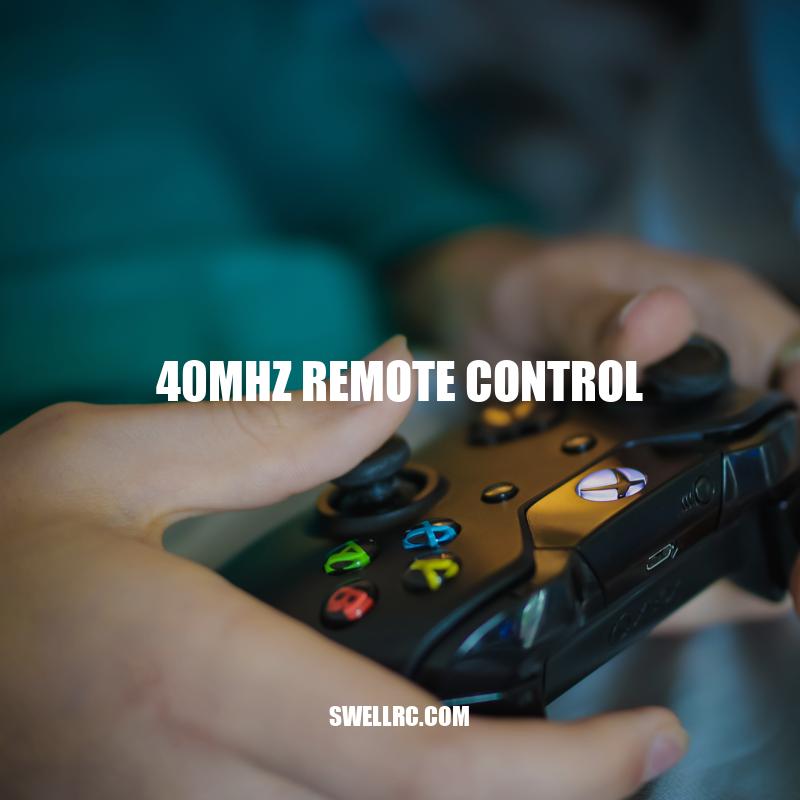Understanding 40MHz Remote Controls: Advantages, Limitations, and Future
40MHz remote control is a widely used form of wireless radio frequency technology that enables users to control various types of toys and electronic devices from a distance. It operates on a frequency of 40 megahertz, which is capable of transmitting signals over several hundred feet. The device uses a transmitter and a receiver module to transmit and receive signals. The transmitter sends encoded radio signals to the receiving module, which then decodes the radio signals and applies the appropriate action. 40MHz remote controls are relatively affordable and simple to use, and they are ideal for controlling toy vehicles, hobby models, and other electronic devices. They often have multiple channels, which allows users to control multiple devices with a single controller. Despite these advantages, however, 40MHz remote controls are not without limitations. They are susceptible to interference from other devices operating on the same frequency and may be less secure than other types of remote controls that use more secure frequency hopping techniques. Nonetheless, they remain popular among hobbyists and casual users who seek a reliable, scalable, and cost-effective way to control various types of electronic devices and toys.
How Does a 40MHz Remote Control Work?
A 40MHz remote control works by transmitting signals using a frequency of 40 megahertz. The controller, which typically consists of a handheld device with a few buttons, sends a signal to the device being controlled. The device being controlled, whether it is a toy vehicle, hobby model, or electronic device, is equipped with a receiver that receives and interprets the signal from the controller. Some of the key features of 40MHz remote controls include:
- Relatively inexpensive compared to other types of remote controls
- Easy to use, with simple button controls that are easy to understand and operate
- Reliable range of several hundred feet, making them suitable for indoor and outdoor use
- Multiple channels, which allow users to control multiple devices with one remote control
While 40MHz remote controls are generally reliable and easy to use, they have some key limitations to keep in mind:
- Susceptible to interference from other devices operating on the same frequency
- May be less secure than other types of remote controls that use more secure frequency hopping techniques
Despite these limitations, 40MHz remote control devices are still a popular and viable option for many casual users and hobbyists. Those interested in purchasing a 40MHz remote control should research various models and manufacturers to find the best option for their specific needs. Online retailers such as Amazon and eBay offer a wide selection of remote control devices at various price points, and specialized hobby stores may also carry 40MHz remote controls and accessories.
What frequency does a remote control use?
Practically, RF remote controls use 315, 434 or 868 MHz as RF carrier frequency.
The Advantages of 40MHz Remote Controls
While 40MHz remote controls may have some limitations, they also offer some distinct advantages that make them a popular choice for many users. Some of the key advantages of 40MHz remote controls include:
- Relatively inexpensive compared to other types of remote controls
- Easy to use, with simple button controls that are easy to understand and operate
- Reliable range of several hundred feet, making them suitable for indoor and outdoor use
- Multiple channels, which allow users to control multiple devices with one remote control
An additional advantage of 40MHz remote controls is that they are versatile, allowing them to be used in a wide range of applications. For example, they are commonly used for controlling toy vehicles such as remote control cars, boats, and airplanes. They are also used for hobbyist models such as remote control helicopters and drones. In addition, 40MHz remote controls can be used for various electronic devices such as televisions, stereo systems, and other home electronics.
Another interesting fact about 40MHz remote controls is that they have been around for nearly four decades, having first been developed in the early 1980s. Despite the advent of newer technologies in the intervening years, 40MHz remotes continue to be used by a large number of enthusiasts and hobbyists.
Those interested in purchasing a 40MHz remote control should research various models and manufacturers to find the best option for their specific needs. Online retailers such as Amazon and eBay offer a wide selection of remote control devices at various price points, and specialized hobby stores may also carry 40MHz remote controls and accessories.
Table: Comparing 40MHz Remote Controls to Other Types of Remote Controls
| Feature | 40MHz Remote Controls | Bluetooth Remote Controls | Wi-Fi Remote Controls |
|---|---|---|---|
| Price | Low to moderate | Moderate to high | High |
| Range | Several hundred feet | 30-60 feet | Up to 100 feet or more |
| Security | Less secure than Bluetooth or Wi-Fi | More secure than 40MHz | Most secure option |
| Compatibility | Works with many types of devices | Requires Bluetooth-enabled devices | Requires Wi-Fi-enabled devices |
What is the advantage of remote control?
A remote control provides the advantage of being able to operate a machine or device from a distance, which saves time and allows for greater convenience. With control at your fingertips wherever you are, you can easily manage devices in any circumstance. This can be especially useful for home entertainment systems or smart home devices, as it allows you to easily switch between different sources or adjust settings without physically interacting with the device. There are various websites and products that offer remote control solutions for different types of devices, such as Logitech Harmony or Amazon Alexa.
The Limitations of 40MHz Remote Controls
While 40MHz remote controls offer some advantages, they also have several limitations that users should be aware of before making a purchase. Some of the key limitations of 40MHz remote controls include:
- Interference: 40MHz remote controls are vulnerable to interference from other devices using the same frequency, which can impact signal quality and range.
- Vulnerability: Because 40MHz remote controls operate on a single frequency, they may be less secure than other types of remotes that use more secure frequency hopping techniques.
- Line of sight: 40MHz remote controls require a clear line of sight between the remote and the device being controlled, which can limit their use in certain situations.
- Compatibility: Some devices, particularly newer models, may not be compatible with 40MHz remote controls.
One way to address some of these limitations is to consider using a different type of remote control technology. For example, Bluetooth remote controls offer higher security and compatibility with a wider range of devices, while Wi-Fi remote controls offer greater range and flexibility.
However, for users who prefer the simplicity and affordability of 40MHz remote controls, there are some steps that can be taken to minimize the impact of these limitations. For example, using rechargeable batteries can help to reduce costs and minimize the environmental impact of disposable batteries. In addition, users can reduce the risk of interference by using their remote control in areas with minimal electronic activity, such as in the countryside or away from major cities.
It is worth researching the specific limitations of any remote control technology before making a purchase, as different technologies may offer different benefits and drawbacks depending on the user’s needs and preferences. Websites such as RC Planet and Hobbytron offer a wide range of remote control devices and accessories, as well as user reviews and specifications that can help users make an informed decision.
What is the technology of remote control?
Remote control technology allows us to operate a device from a distance without being physically connected to it. This technology incorporates infrared or radio signals to transmit commands to the device. Infrared remotes use light signals to communicate with the device, while radio remotes use radio frequency signals. The remote control technology has evolved over the years, and modern-day remotes come with advanced features like voice commands and touchscreens. Several websites provide in-depth information about remote control technology. You can also find a wide range of remote control products on popular e-commerce websites like Amazon and Best Buy.
The Future of 40MHz Remote Controls
While 40MHz remote controls have been a popular option for controlling electronic devices and toys for several decades, technological advancements are slowly phasing them out. Newer technologies, such as Bluetooth and Wi-Fi control, offer more advanced features and greater security, making them better options in many circumstances. These technologies also allow for greater customization and control, with some devices even allowing users to control their appliances remotely from a smartphone app.
Despite these advancements, 40MHz remote controls will continue to be a popular option for hobbyists and casual users due to their affordability and simplicity. Additionally, in some cases, they may be the only option available for controlling certain devices or toys. As such, it is likely that the demand for 40MHz remote controls will remain steady in the near future.
Overall, while 40MHz remote controls may have some limitations, they are still a reliable and affordable option for many users. As technology continues to advance, there may come a time when they are no longer widely used. However, for now, they remain a popular option for those who want to control their devices and toys from a distance without breaking the bank. Whether you are a hobbyist, a parent looking to buy a toy for your child, or simply in need of a reliable remote control, a 40MHz remote may be just what you need.



